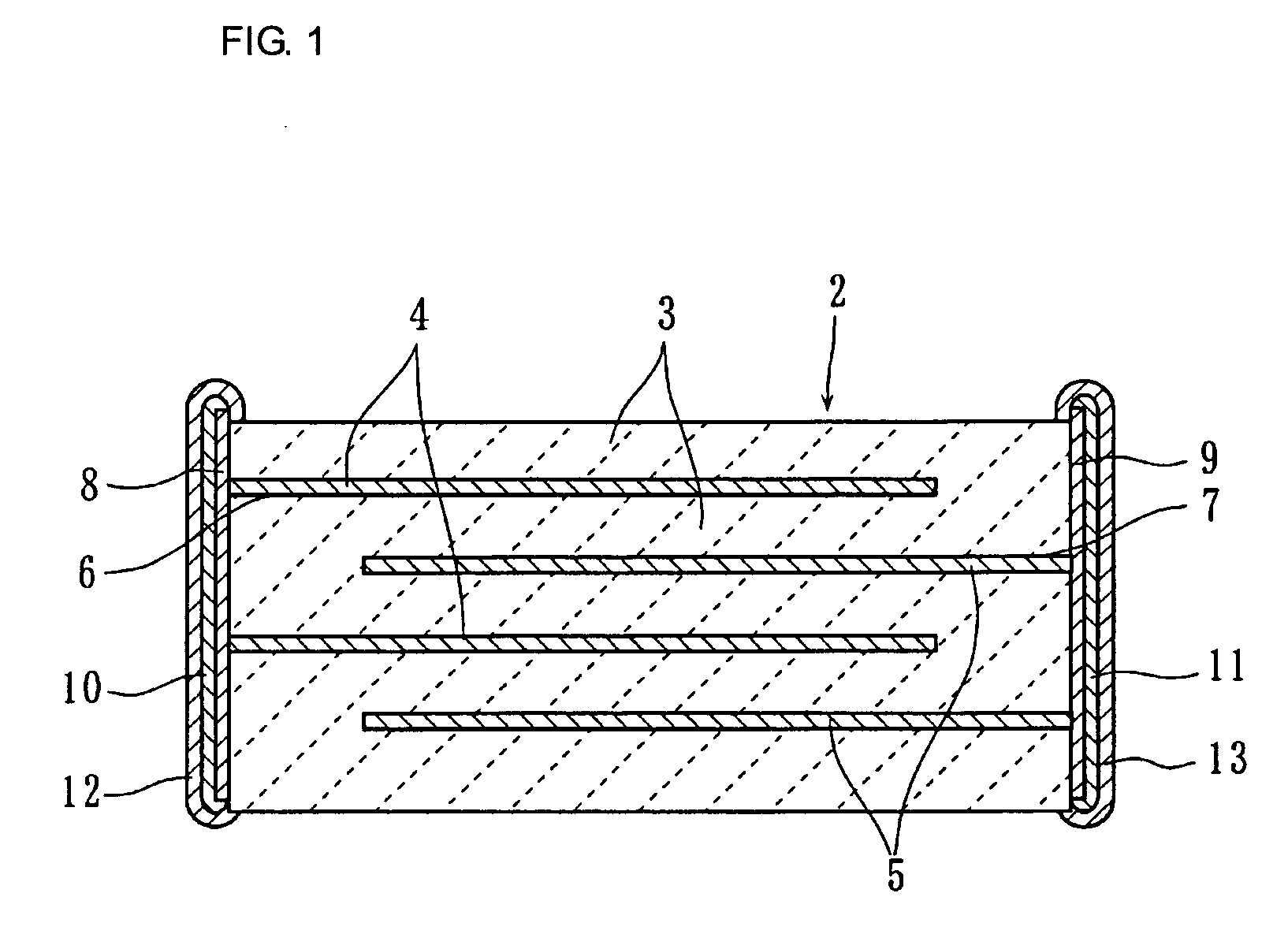Dielectric ceramic and multilayer ceramic capacitor
- Summary
- Abstract
- Description
- Claims
- Application Information
AI Technical Summary
Benefits of technology
Problems solved by technology
Method used
Image
Examples
example 1
[0086] In Example 1, the change in properties of a multilayer ceramic capacitor which was obtained when the composition of a dielectric ceramic and the solid solution state of Cu were changed was confirmed.
[0087] First, as ceramic raw materials, powdered BaCO3, TiO2 and CuO were prepared and weighed to satisfy the compositions of Sample Nos. 1 to 31 shown in Table 1. Next, the weighed materials were charged in a ball mill containing PSZ (partly stabilized zirconia) balls, were mixed and pulverized, and were then dried, so that a mixed powder was obtained. Subsequently, this mixed powder was processed by a calcination treatment at 1,150° C. for 2 hours, and hence, a primary component powder represented by the general formula: Bam(Ti1-xCux)O3 was formed.
[0088] Next, powders of Dy2O3, Gd2O3, La2O3, Eu2O3, Pr6O11, Er2O3, CeO2, Nd2O3, Ho2O3, Sm2O3, Y2O3, Tb2O3, Lu2O3, Yb2O3 and Tm2O3 as a rare earth oxide containing a rare earth element Re, and powders of MnO, Fe2O3, V2O5, NiO, CO3O4, ...
example 2
[0125] In Example 2, the influence of a solid-solution rate of the rare earth element Re in the primary phase grain was confirmed.
[0126] After a ceramic laminate having the same composition as that of Sample No. 1 of Example 1 was formed and was then heated to 350° C. in a nitrogen atmosphere as a debinder treatment, firing was performed in a reducing atmosphere of a H2—N2—H2O gas at an oxygen partial pressure of 10 MPa and at a temperature in the range of 980 to 1,250° C. for 2 hours, so that a multilayer sintered body including internal electrodes therein was formed. Subsequently, by a method and procedure similar to those of Example 1, multilayer ceramic capacitors of Sample Nos. 41 to 48 were formed.
[0127] Next, after the samples of Samples Nos. 41 to 48 were cut, the cross-sections thereof were observed using a FE-TEM-EDX in a manner similar to that in Example 1, so that the solid-solution area ratio of Dy in the primary phase grain was obtained. That is, 20 crystal grains we...
example 3
[0133] In Example 3, the influences of the molar ratio t of Ca in the B site and the molar ratio u of Zr in the Ti site were confirmed.
[0134] First, as ceramic raw materials, powdered BaCO3, TiO2, and CuO were prepared and weighed to satisfy the compositions of Sample Nos. 51 to 68 shown in Table 4. Next, the weighed materials were charged in a ball mill containing PSZ balls, were mixed and pulverized, and were then dried, so that a mixed powder was obtained. Subsequently, this mixed powder was processed by a calcination treatment at 1,150° C. for 2 hours, and hence, a primary component powder represented by the general formula: (Ba1-tCat)1.010(Ti0.090-uZruCu0.010)O3 was formed.
[0135] Next, with respect to 100 molar parts of the primary component, 1.0 molar part of Dy2O3, 0.3 molar parts of MnO, 1.0 molar part of MgO, and 1.0 molar part of SiO2 were added and were then mixed together in a ball mill containing PSZ balls, followed by drying, so that a ceramic material powder was obt...
PUM
| Property | Measurement | Unit |
|---|---|---|
| Fraction | aaaaa | aaaaa |
| Mass | aaaaa | aaaaa |
| Length | aaaaa | aaaaa |
Abstract
Description
Claims
Application Information
 Login to View More
Login to View More - R&D
- Intellectual Property
- Life Sciences
- Materials
- Tech Scout
- Unparalleled Data Quality
- Higher Quality Content
- 60% Fewer Hallucinations
Browse by: Latest US Patents, China's latest patents, Technical Efficacy Thesaurus, Application Domain, Technology Topic, Popular Technical Reports.
© 2025 PatSnap. All rights reserved.Legal|Privacy policy|Modern Slavery Act Transparency Statement|Sitemap|About US| Contact US: help@patsnap.com


